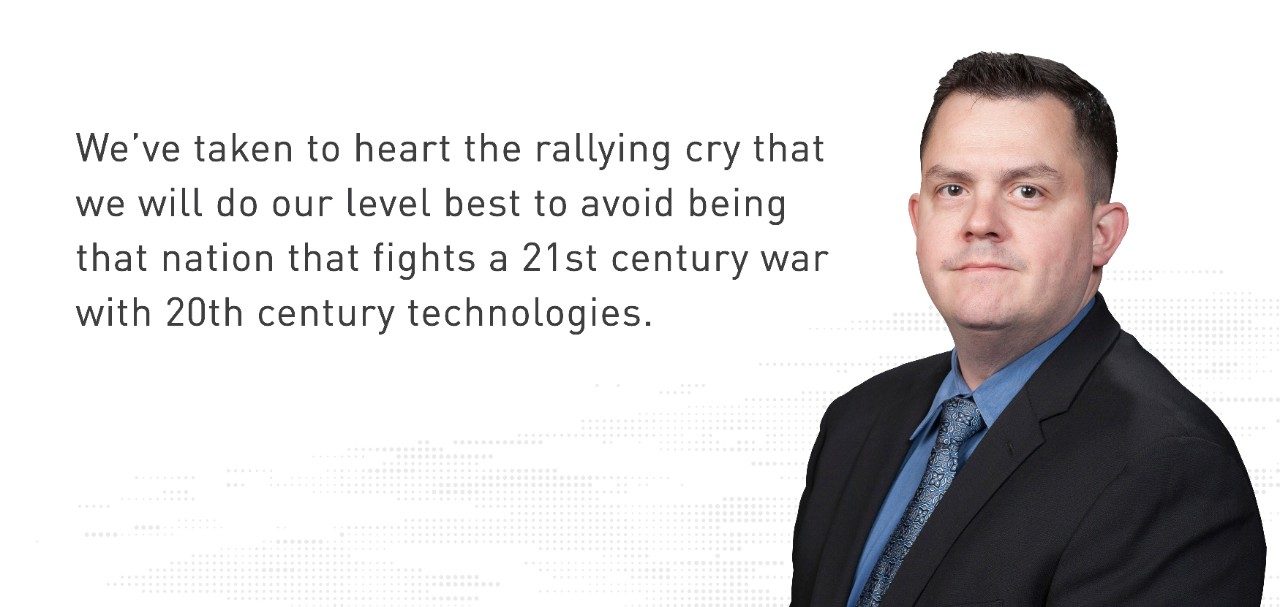Imagine this nightmare scenario…
You wake up to initial reports on social media that a nation has declared war against your country. Hours later, news organizations are reporting it worldwide. The opening shots of this war weren’t carried out with bullets or bombs, but with keystrokes.
The adversary has taken off the gloves and is conducting advanced combat – not the kind of hybrid warfare we’ve seen in different scenarios across the world, but the sort of open hostility and we haven’t seen for quite some time. This combat is punctuated with crippling effects like:
- Loss of most of our strategic weaponry
- Loss of satellite networks
- Loss of communication backbones
- Loss of tactical access to precision navigation and timing
One thing is common. All of it relies on technology that failed to adapt to an advanced threat.
The question is – how do we shore up our advantage and prevent this from ever happening?

That scenario is from the opening act of a recent novel. While the story itself is great fiction, it carries an important message about the responsibility we bear when we rely on technology. The takeaway is that the technology of today must evolve constantly. Our adversaries are always looking at ways to outpace us.
To avoid that nightmare scenario, the U.S. must lead the charge into the next evolution – in both technology development and the way we use it. The aerospace & defense industry must invest in and mature new technologies by focusing on three key priorities:
- Revolutionary simplicity
- Right decisions, faster
- Making it all work together
Revolutionary Simplicity
The first pillar is about revolutionary simplicity; meaning major weapon systems must be synchronized so that commanders can bring effects that previously took hours, if not days to coordinate, within seconds.
This includes taking information from sensors, environmental forecasting, situational data, and even current geopolitical reporting and federating it into a common operating picture. That common picture should be able to be viewed and utilized at all levels of combat. We’re producing solutions that speed data analysis and give alternatives to the decision makers who need it most. It needs to be simple because the complex should already be worked out in the lab. Superior information and situational understanding can make hard decisions a whole lot simpler to make.
Right Decisions Faster
The second pillar deals with the ability to make the right decisions faster. Lockheed Martin wants to put data and every conceivable alternative into a commander’s hands. Next generation combat is going to require new tactics to apply to classic missions like:
- Disruption of combat multipliers
- Predictive analysis
- Predictive maintenance
- Manipulating the information environment
- All coupled tightly with long range precision fires
We are adding options that never existed before. Knowing what is within the realm of possible, we also want to defend our assets against enemies who have done nothing but study the American way of war. We’ll get there by embracing nascent technologies like artificial intelligence (AI) and machine learning. Those tools enable resilient networks and connect them to an interoperable worldwide backbone. This translates into information dominance that supports the kind of rapid decision making that’s required in a future fight.
Our adversaries are continually improving their positions on the multi-domain fighting surface. Concurrently, they are developing and testing offensive tools in the real world as we speak. So, when do we act?
The time to act isn’t today. It isn’t yesterday … it’s years ago.
This is exactly why Lockheed Martin has spent decades researching the concepts and investing in the infrastructures required to meet existential threats today and into the future. We must also recognize that the state-of-the-art solution today will pale in comparison to the next technological evolution. And so, we continue to work harder to create answers to questions that haven’t been asked yet. And be there for our customers when they require the next innovation.
Making It All Work Together
The third pillar is the difference the Lockheed Martin team makes. Multi-Domain Operations (MDO) means developing and demonstrating MDO-enabling systems that are ready for operational use today. The next great MDO solutions could come from anyone. As an early adopter of open systems architecture, we support widening the aperture to ensure that the customer is free to make the choices that support their mission.
We have showed the world what a future system could look like earlier this year with the flight test of the Multi-Function Electronic Warfare System-Air Large – an open system architecture weapon for the U.S. Army that has the ability to stay relevant well into the next combat evolution.
In addition to combat system longevity, an open standard means:
- Less barriers to great innovation
- Ease of maintenance
- System components that are lighter and more capable
- Combat systems stay in the fight longer and spend less time in updates or modifications
Moreover, it means that we get that much closer to interoperability and a resilient network that provides not just situational awareness but situational understanding. Ultimately, it means we deliver a new list of options that makes sense to the commander, ahead of schedule, to close that decision loop faster, time and again.
To get back to the question of “how we shore up our advantage?” It’s about knowing the cutting-edge technologies of today will not be enough. It’s the technologies and vision of what could be that will continue to keep us safe.




